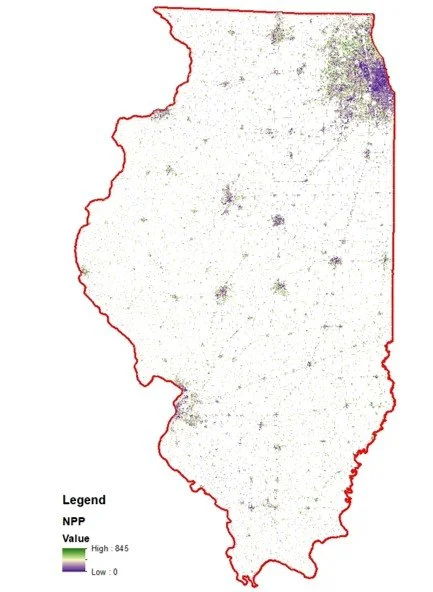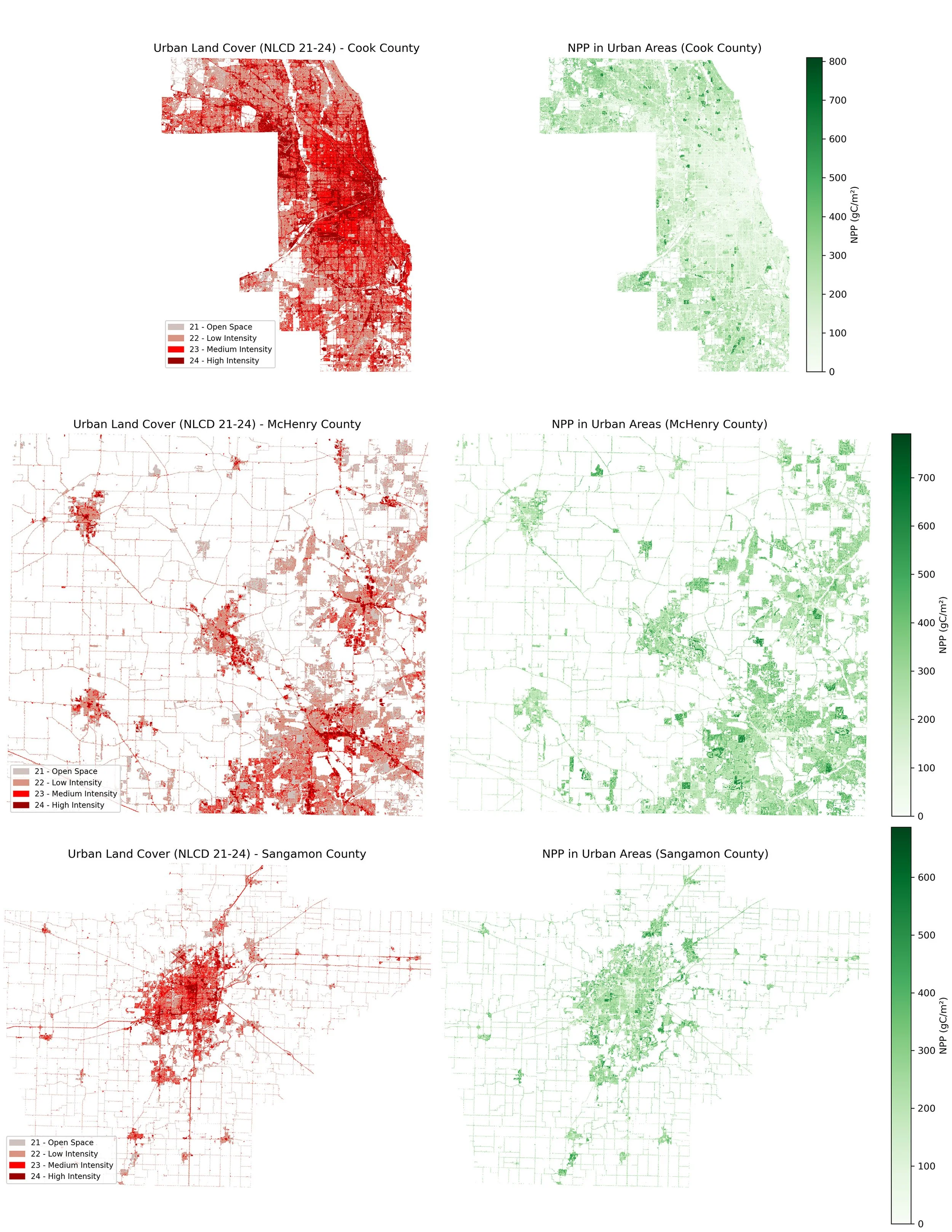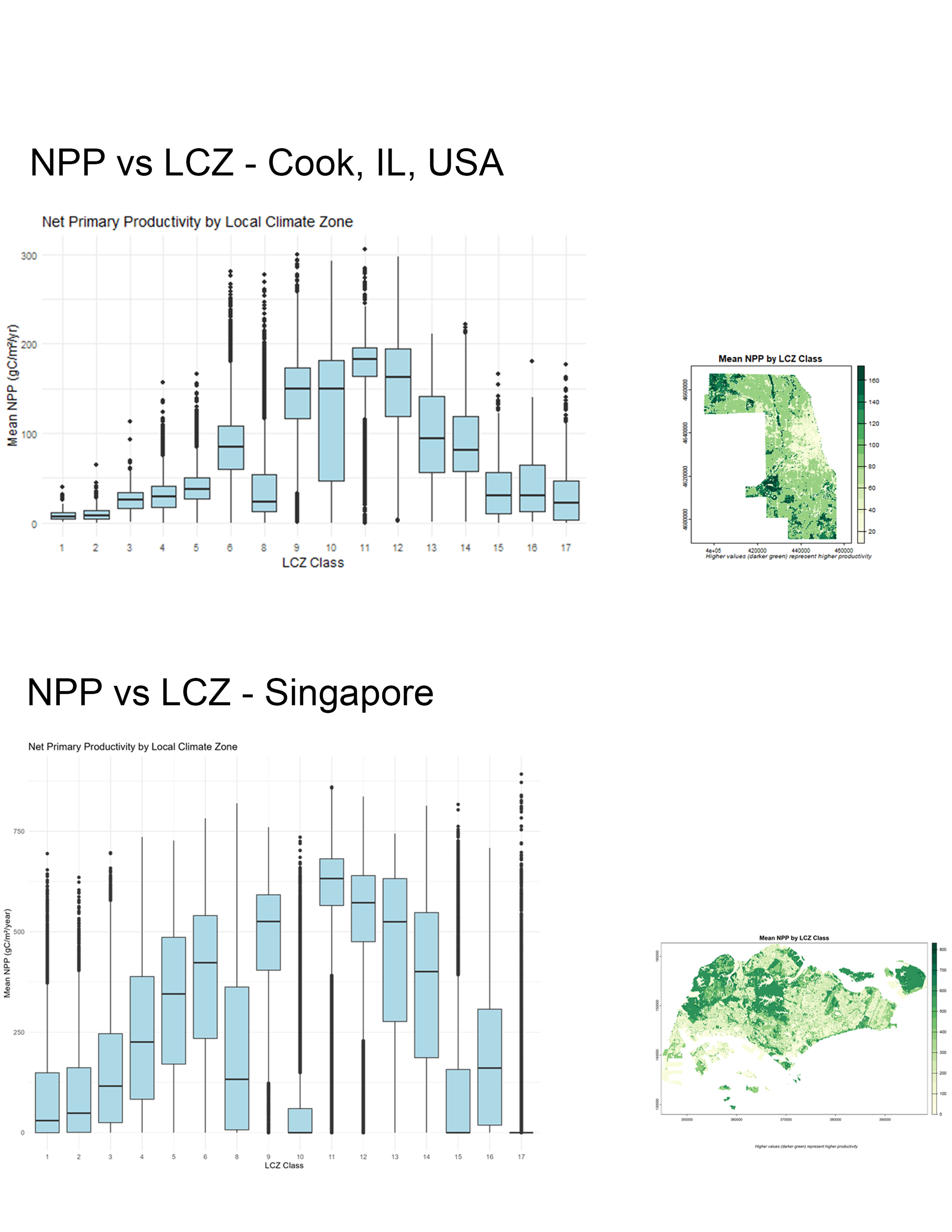
Carbon Dynamics & Sequestration Analysis
Develop metrics and models to quantify how urban landscapes capture or release carbon, revealing critical tipping points and opportunities for climate intervention through strategic vegetation management and land use planning.
Understanding the Carbon Sequestration Potential of Urban Landscapes: A State-wide Assessment in Illinois
Yijun Zeng, Jiajia Wang, Siqi Lai, Brian Deal
University of Illinois at Urbana-Champaign
This research provides a comprehensive statewide analysis of urban carbon sequestration potential in Illinois, bridging the gap between local climate actions and broader political scales needed for carbon neutrality planning. Using net primary productivity (NPP) data and landcover classification, we quantify urban areas' contribution at 8.52% of Illinois's total sequestration capacity. The study reveals nuanced relationships between urban intensity, socioeconomic factors, and carbon capture—with surprising findings including positive effects from housing vacancy and significant negative correlations with housing cost burden. These insights demonstrate how urban vegetation, land use patterns, and social dynamics intersect to shape sequestration potential, offering evidence-based strategies for integrating urban areas into statewide climate action plans.
Click the image to view the full paper.
Understanding the Carbon Sequestration Potential in Urban Landscapes: The Case Study of IL Counties
Yijun Zeng 1, Jiajia Wang 2, Brian Deal 2
1 Iowa State University
2 University of Illinois at Urbana-Champaign
This research investigates how urban areas can contribute to Illinois's 2050 carbon neutrality goal through nature-based sequestration strategies. Moving beyond traditional assessment methods that rely on averaged data, this study employs fine-scale analysis using NPP data, digital maps, and satellite imagery to precisely measure carbon sequestration potential across urban, suburban, and rural Illinois counties. By examining the relationship between socioeconomic factors and carbon capture in developed areas, the research reveals surprising insights—such as the positive impact of housing vacancy on sequestration and the correlation between residential stability and landscape carbon storage. These findings offer planners and designers actionable strategies for maximizing urban vegetation's role in climate mitigation at both county and neighborhood scales.
Presented at CELA 2025 Annual Conference
Form, Function, and Equity in the Urban Carbon Cycle: A Comparative Study of Local Climate Zones, Net Primary Production, and Socioeconomic Impacts in Cook County, IL, and Singapore
Jiajia Wang 1, Yixin Wu 2
1 University of Illinois at Urbana-Champaign
2 National University of Singapore
This study explores how urban morphology influences ecosystem productivity in Cook County, Illinois, and Singapore. Using the CASA model and Local Climate Zone (LCZ) classifications, it shows that greener urban forms (dense or scattered trees, sparsely built areas) contribute most to carbon sequestration and Net Primary Productivity (NPP). Urban form explains a substantial share of NPP variation in both regions. Socioeconomic factors also shape outcomes: in Cook County, higher income and family stability align with greater NPP, while in Singapore, denser housing and high ownership rates reduce NPP. The findings highlight that urban planning integrating morphology and socio-ecological factors can strengthen climate resilience, equity, and ecological productivity.
Presented at City+ Oxford 2025 Conference
The 2029 Carbon Tipping Point: Integrated Strategies Needed to Maintain Urban Vegetation Carbon Sinks in Illinois
Jiajia Wang, Zhihan Tao, Brian Deal
University of Illinois at Urbana-Champaign
Vegetation is widely assumed to function as a carbon sink, but full life-cycle accounting including vegetation carbon, soil respiration, and management emissions reveals a more complex reality in urban areas. Urban vegetation in Illinois faces significant challenges in maintaining its carbon sink functionality under business-as-usual conditions. Using remote sensing, process-based modeling, and scenario analysis (2015-2060), we quantified temporal carbon flux dynamics across urban development intensities statewide.
Our analysis reveals concerning trends in the relationship between carbon sequestration and emissions in urban vegetation systems, with trajectories suggesting a critical transition point in the near future. We evaluated six intervention scenarios to assess mitigation potential, including technology-based interventions (electric equipment adoption and bio-fertilizer transition) and integrated strategies combining technology adoption with open space expansion.
Results demonstrate that while individual technological interventions provide measurable benefits, only comprehensive integrated strategies show promise for maintaining long-term carbon sink functionality. The findings highlight the urgency for comprehensive management strategies to support Illinois's 2050 net-zero targets and underscore the importance of proactive policy interventions in urban vegetation management.



